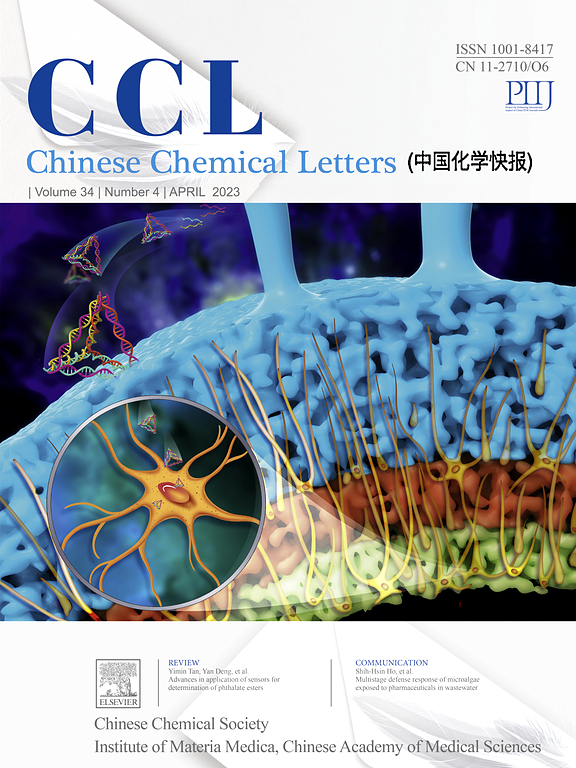用于癌症治疗的铁基金属有机框架纳米平台:微型综述
IF 8.9
1区 化学
Q1 CHEMISTRY, MULTIDISCIPLINARY
引用次数: 0
摘要
迄今为止,包括化学动力疗法、光热疗法、光动力疗法、声动力疗法、免疫疗法和化疗在内的众多新兴癌症治疗方法已迅速进入新的发展阶段。然而,单一的治疗模式往往受制于复杂的肿瘤微环境。近来,纳米材料和纳米医学的出现为克服肿瘤治疗学的局限性提供了很好的途径。特别是金属有机框架(MOFs),由于其形态可定制、易于功能化、比表面积大、生物相容性好等特点,在癌症治疗中获得了极大的关注。在这些 MOFs 中,铁基 MOFs(Fe-MOFs)因其具有纳米光敏剂、过氧化物酶样活性、生物成像对比能力和生物可降解性等特性,在癌症治疗中尤其具有广阔的前景。利用其结构的规则性和合成可调性,Fe-MOFs 可与有机分子或其他无机纳米粒子结合,从而创造出单一或组合治疗模式的多功能纳米平台。在此,小编将重点介绍基于 Fe-MOFs 的纳米平台在肿瘤部位自我增强成像和治疗方面的最新进展。此外,还讨论了基于 Fe-MOFs 的纳米平台的临床研究发展,探讨了未来的主要挑战和创新。我们的综述旨在让新手研究人员对先进的癌症治疗模式有一个基础性的了解,并通过对 Fe-MOFs 的改性促进其临床应用。本文章由计算机程序翻译,如有差异,请以英文原文为准。

Engineered iron-based metal-organic frameworks nanoplatforms for cancer theranostics: A mini review
Up to now, numerous emerging methods of cancer treatment including chemodynamic therapy, photothermal therapy, photodynamic therapy, sonodynamic therapy, immunotherapy and chemotherapy have rapidly entered a new stage of development. However, the single treatment mode is often constrained by the complex tumor microenvironment. Recently, the nanomaterials and nanomedicine have emerged as promising avenues to overcome the limitation in cancer theranostics. Especially, metal-organic frameworks (MOFs) have gained considerable interests in cancer therapy because of their customizable morphologies, easy functionalization, large specific surface area, and good biocompatibility. Among these MOFs, iron-based MOFs (Fe-MOFs) are particularly promising for cancer treatment due to their properties as nano-photosensitizers, peroxidase-like activity, bioimaging contrast capabilities, and biodegradability. Utilizing their structural regularity and synthetic tunability, Fe-MOFs can be engineered to incorporate organic molecules or other inorganic nanoparticles, thereby creating multifunctional nanoplatforms for single or combined theranostic modes. Herein, the minireview focuses on the recent advancements of the Fe-MOFs-based nanoplatforms for self-enhanced imaging and treatment at tumor sites. Furthermore, the clinical research development of Fe-MOFs-based nanoplatforms is discussed, addressing key challenges and innovations for the future. Our review aims to provide novice researchers with a foundational understanding of advanced cancer theranostic modes and promote their clinical applications through the modification of Fe-MOFs.
求助全文
通过发布文献求助,成功后即可免费获取论文全文。
去求助
来源期刊

Chinese Chemical Letters
化学-化学综合
CiteScore
14.10
自引率
15.40%
发文量
8969
审稿时长
1.6 months
期刊介绍:
Chinese Chemical Letters (CCL) (ISSN 1001-8417) was founded in July 1990. The journal publishes preliminary accounts in the whole field of chemistry, including inorganic chemistry, organic chemistry, analytical chemistry, physical chemistry, polymer chemistry, applied chemistry, etc.Chinese Chemical Letters does not accept articles previously published or scheduled to be published. To verify originality, your article may be checked by the originality detection service CrossCheck.
 求助内容:
求助内容: 应助结果提醒方式:
应助结果提醒方式:


